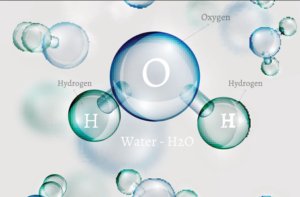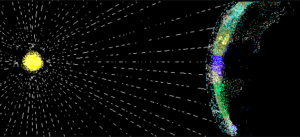Read: Problem Solving With Scientific Notation
Learning Objectives
- Solve application problems involving scientific notation
 Water Molecule
Water MoleculeSolve application problems
Learning rules for exponents seems pointless without context, so let's explore some examples of using scientific notation that involve real problems. First, let's look at an example of how scientific notation can be used to describe real measurements.Think About It
Match each length in the table with the appropriate number of meters described in scientific notation below. Write your ideas in the textboxes provided before you look at the solution.| The height of a desk | Diameter of water molecule | Diameter of Sun at its equator |
| Distance from Earth to Neptune | Diameter of Earth at the Equator | Height of Mt. Everest (rounded) |
| Diameter of average human cell | Diameter of a large grain of sand | Distance a bullet travels in one second |
| Power of 10, units in meters | Length from table above |
| [latex]10^{12}[/latex] | [practice-area rows="1"][/practice-area] |
| [latex]10^{9}[/latex] | [practice-area rows="1"][/practice-area] |
| [latex]10^{6}[/latex] | [practice-area rows="1"][/practice-area] |
| [latex]10^{4}[/latex] | [practice-area rows="1"][/practice-area] |
| [latex]10^{2}[/latex] | [practice-area rows="1"][/practice-area] |
| [latex]10^{0}[/latex] | [practice-area rows="1"][/practice-area] |
| [latex]10^{-3}[/latex] | [practice-area rows="1"][/practice-area] |
| [latex]10^{-5}[/latex] | [practice-area rows="1"][/practice-area] |
| [latex]10^{-10}[/latex] | [practice-area rows="1"][/practice-area] |
Answer:
| Power of 10, units in meters | Length from table above |
| [latex]10^{12}[/latex] | Distance from Earth to Neptune |
| [latex]10^{9}[/latex] | Diameter of Sun at it's Equator |
| [latex]10^{6}[/latex] | Diameter of Earth at the Equator |
| [latex]10^{4}[/latex] | Height of Mt. Everest (rounded) |
| [latex]10^{2}[/latex] | Distance a bullet travels in one second |
| [latex]10^{0}[/latex] | The height of a desk |
| [latex]10^{-3}[/latex] | Diameter of a large grain of sand |
| [latex]10^{-5}[/latex] | Diameter of average human cell |
| [latex]10^{-10}[/latex] | Diameter of water molecule |
 Red Blood Cells
Red Blood CellsExample
Human cells come in a wide variety of shapes and sizes. The mass of an average human cell is about [latex]2\times10^{-11}[/latex] grams[footnote]Orders of magnitude (mass). (n.d.). Retrieved May 26, 2016, from https://en.wikipedia.org/wiki/Orders_of_magnitude_(mass)[/footnote]Red blood cells are one of the smallest types of cells[footnote]How Big is a Human Cell?[/footnote], clocking in at a volume of approximately [latex]10^{-6}\text{ meters }^3[/latex].[footnote]How big is a human cell? - Weizmann Institute of Science. (n.d.). Retrieved May [latex]26, 2016[/latex], from http://www.weizmann.ac.il/plants/Milo/images/humanCellSize120116Clean.pdf[/footnote] Biologists have recently discovered how to use the density of some types of cells to indicate the presence of disorders such as sickle cell anemia or leukemia. [footnote]Grover, W. H., Bryan, A. K., Diez-Silva, M., Suresh, S., Higgins, J. M., & Manalis, S. R. (2011). Measuring single-cell density. Proceedings of the National Academy of Sciences, 108(27), 10992-10996. doi:10.1073/pnas.1104651108[/footnote] Density is calculated as the ratio of [latex]\frac{\text{ mass }}{\text{ volume }}[/latex]. Calculate the density of an average human cell.Answer: Read and Understand: We are given an average cellular mass and volume as well as the formula for density. We are looking for the density of an average human cell. Define and Translate: [latex]m=\text{mass}=2\times10^{-11}[/latex], [latex]v=\text{volume}=10^{-6}\text{ meters}^3[/latex], [latex]\text{density}=\frac{\text{ mass }}{\text{ volume }}[/latex] Write and Solve: Use the quotient rule to simplify the ratio.
[latex]\begin{array}{c}\text{ density }=\frac{2\times10^{-11}\text{ grams }}{10^{-6}\text{ meters }^3}\\\text{ }\\\,\,\,\,\,\,\,\,\,\,\,\,\,\,\,\,\,\,\,\,\,\,\,\,\,\,\,\,\,\,\,\,\,\,\,\,\,=2\times10^{-11-\left(-6\right)}\frac{\text{ grams }}{\text{ meters }^3}\\\text{ }\\\,\,\,\,\,\,\,\,\,\,\,\,\,\,\,\,\,\,\,\,\,\,\,=2\times10^{-5}\frac{\text{ grams }}{\text{ meters }^3}\\\end{array}[/latex]
If scientists know the density of healthy cells, they can compare the density of a sick person's cells to that to rule out or test for disorders or diseases that may affect cellular density.Answer
The average density of a human cell is [latex]2\times10^{-5}\frac{\text{ grams }}{\text{ meters }^3}[/latex]
 Light traveling from the sun to the earth.
Light traveling from the sun to the earth.Example
The speed of light is [latex]3\times10^{8}\frac{\text{ meters }}{\text{ second }}[/latex]. If the sun is [latex]1.5\times10^{11}[/latex] meters from earth, how many seconds does it take for sunlight to reach the earth? Write your answer in scientific notation.Answer: Read and Understand: We are looking for how long—an amount of time. We are given a rate which has units of meters per second and a distance in meters. This is a [latex]d=r\cdot{t}[/latex] problem. Define and Translate:
[latex]\begin{array}{l}d=1.5\times10^{11}\\r=3\times10^{8}\frac{\text{ meters }}{\text{ second }}\\t=\text{ ? }\end{array}[/latex]
Write and Solve: Substitute the values we are given into the [latex]d=r\cdot{t}[/latex] equation. We will work without units to make it easier. Often, scientists will work with units to make sure they have made correct calculations.
[latex]\begin{array}{c}d=r\cdot{t}\\1.5\times10^{11}=3\times10^{8}\cdot{t}\end{array}[/latex]
Divide both sides of the equation by [latex]3\times10^{8}[/latex] to isolate t.
[latex]\begin{array}{c}1.5\times10^{11}=3\times10^{8}\cdot{t}\\\text{ }\\\frac{1.5\times10^{11}}{3\times10^{8}}=\frac{3\times10^{8}}{3\times10^{8}}\cdot{t}\end{array}[/latex]
On the left side, you will need to use the quotient rule of exponents to simplify, and on the right, you are left with t.
[latex]\begin{array}{c}\frac{1.5\times10^{11}}{3\times10^{8}}=\frac{3\times10^{8}}{3\times10^{8}}\cdot{t}\\\text{ }\\\left(\frac{1.5}{3}\right)\times\left(\frac{10^{11}}{10^{8}}\right)=t\\\text{ }\\\left(0.5\right)\times\left(10^{11-8}\right)=t\\0.5\times10^3=t\end{array}[/latex]
This answer is not in scientific notation, so we will move the decimal to the right, which means we need to subtract one factor of [latex]10[/latex].
[latex]0.5\times10^3=5.0\times10^2=t[/latex]
Answer
The time it takes light to travel from the sun to the earth is [latex]5.0\times10^2=t[/latex] seconds, or in standard notation, [latex]500[/latex] seconds. That's not bad considering how far it has to travel!Summary
Scientific notation was developed to assist mathematicians, scientists, and others when expressing and working with very large and very small numbers. Scientific notation follows a very specific format in which a number is expressed as the product of a number greater than or equal to one and less than ten, and a power of [latex]10[/latex]. The format is written [latex]a\times10^{n}[/latex], where [latex]1\leq{a}<10[/latex] and n is an integer. To multiply or divide numbers in scientific notation, you can use the commutative and associative properties to group the exponential terms together and apply the rules of exponents.Licenses & Attributions
CC licensed content, Original
- Revision and Adaptation. Provided by: Lumen Learning License: CC BY: Attribution.
- Application of Scientific Notation - Quotient 1 (Number of Times Around the Earth). Authored by: James Sousa (Mathispower4u.com) for Lumen Learning. License: CC BY: Attribution.
- Application of Scientific Notation - Quotient 2 (Time for Computer Operations). Authored by: James Sousa (Mathispower4u.com) for Lumen Learning. License: CC BY: Attribution.
CC licensed content, Shared previously
- Unit 11: Exponents and Polynomials, from Developmental Math: An Open Program. Provided by: Monterey Institute of Technology and Education Located at: https://www.nroc.org/. License: CC BY: Attribution.
